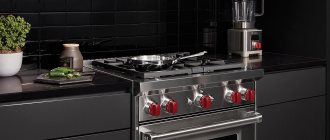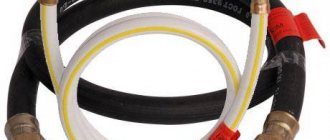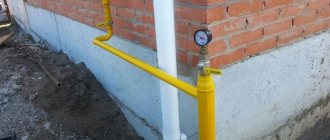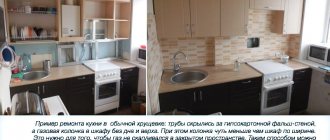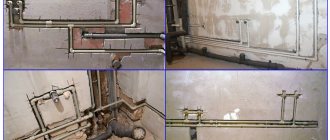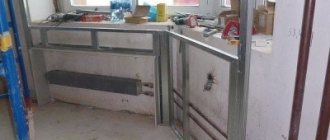How to connect a gas pipe
There are several types of flexible hoses for connecting a gas pipe. Not all of them are equally good, so let's understand the topic in more detail.
Table 1. Hose types
Rubber-fabric options are considered the most affordable of other analogues - for half a meter of such a hose you will have to pay 120 rubles. average. The product immediately includes nuts and gaskets for connecting equipment. These products have the following characteristics: 1. Service life does not exceed 5 years. The quality of the product greatly depends on the quality of the original raw materials. That's why these hoses are inexpensive. They can be used as a temporary solution when nothing else is available. 2. Such a hose does not have a sufficient level of rigidity, which contributes to its accelerated destruction. 3. It cannot withstand high temperatures, so make sure it is kept away from the gas burner. 4. The length of the product can vary from 0.4 to 7 meters.
Today it is prohibited to use oxygen hoses to connect gas installations, since they do not meet safety standards - the material reacts with oils and begins to deteriorate quite quickly. However, in the old fashioned way, many continue to use them - if you do, then only as a temporary measure. These products are: 1. They are sold in coils and do not have a mounted tip, so in addition to the hose itself, you will need to buy two fittings with gaskets. 2. They can withstand high pressure - up to 20 atmospheres, although there is no trace of this in our gas networks. 3. It is very important that rubber does not conduct electricity.
We solve the problem with the help of boxes and false walls
A box consisting of a metal frame covered with plasterboard sheets will help to disguise the wiring. Such rectangular “columns” from floor to ceiling are called pylons. The design must provide a flow of fresh air inside so that gas does not accumulate there. The best option is sheets with perforation. The pylon must have doors, hatches, and removable panels that provide access to the riser.
The easiest way to close the pipes in the kitchen is in the corner. This arrangement will eliminate the need to assemble a box with three walls - in this case, two are enough.
In addition to drywall, plastic, fiberboard, chipboard or plywood are often used. The technology allows you to create a surface with protrusions and niches of any shape. Metal and plastic bend perfectly.
Which ceiling is better to make in the kitchen with a column
SNiP and SP do not describe all materials that can be used for cladding. The main requirement and selection criterion is fire safety. Recommended finishes:
- The ceiling is made of plasterboard - the surface is puttied and then painted. If the chimney approaches the ceiling. Wallpapering is prohibited.
Suspended ceiling of the Armstrong system - at the moment the material is classified as NG (non-flammable). The panels do not ignite on their own and cannot sustain combustion. A good option for furnishing a kitchen.
- PVC panels on the ceiling - in the case of a kitchen with a built-in gas water heater, this cladding option is unacceptable. The panels ignite quickly and release toxic gas when burned. The plastic ceiling directly contradicts current building codes and fire safety rules.
To level the surface, it is allowed to use any gypsum and plaster mixtures, followed by painting with water-based paint. A kitchen with a gas water heater must have a ceiling made without the use of flammable materials. Covering the surface with wallpaper and painting it with enamel is strictly prohibited.
Useful tips
Beginners sometimes make mistakes for which they have to pay.
- Always leave an inspection hatch in the box through which you can get to the gas tap and meter.
- Never change the location of the riser. We have already mentioned this. If such a need arises, contact Gorgaz.
- If you have received permission, do not do the transfer yourself, because it will need to be legalized.
So, this is all on the topic of how to close the riser and remove the gas pipe in the kitchen. You could see for yourself that there are a huge number of options. Which one to choose, everyone decides for themselves. Our recommendations are drywall. If anyone has a different opinion, we are ready to listen.
How to officially install the stove?
To legally connect a gas appliance in an apartment building, you need to know where to go. There are 2 options:
- call a master from Gorgaz;
- contact a licensed service center that has an SRO certificate.
You can read about the rules for submitting an application to the gas service and the cost of Mosgaz services here.
Information on the procedure and list of documents for the initial connection of a gas stove can be found in this article.
And finally, let us remind you that any mistakes when connecting the stove yourself can lead to dire consequences, so it is better to entrust this work to specialists.
The question of camouflage
Is it possible to hide a gas pipe when there is no way to move it? It is possible and necessary. Special boxes are available for sale.
You can come up with your own plan on how to hide the gas pipe, and at the same time the counter in the kitchen.
If you have absolutely no idea how to do this effectively and harmoniously, look at the photo “How to hide gas pipes in the kitchen?”
Premises requirements
From the very beginning, you need to figure out where you can install the stove.
Since 2021, the set of rules (SP) 402.1325800.2018 “Residential buildings. Rules for the design of gas consumption systems." According to this document, the room must be ventilated. It must be equipped with a window with a window, an exhaust ventilation duct, and at the bottom of the door there must be a gap between the floor and the door with an area of at least 0.02 m² to ensure natural ventilation.
100% legal ways to solve the problem
To solve the gas pipeline problem within the framework of current legislation and technical standards, you will have to spend a lot of time interacting with various authorities. There are 3 methods that we will consider.
Gas pipe transfer
If the shape of the pipe does not suit the owner, he can request that the gas service relocate it. The procedure looks like this:
- We contact the local company on whose balance sheet the object is located and write a statement about the need to transfer communications.
- We are expecting a visit from the craftsmen who are to inspect the facility. As a rule, you will have to wait up to 2 weeks for the experts to arrive; in different regions of Russia this period varies by plus/minus 5 working days.
- Development of a utility network relocation project. Most gas companies have a design department that will offer services for developing project documentation. Engineers will carry out the necessary calculations and “draw” the pipe in such a way as to fully realize your wishes, but at the same time not violate the standards. Project development can take from 1 to 4 weeks depending on the workload of the design office.
- Installation. After the project has been developed and agreed upon with the management of the gas company, installers arrive at the site, shut off the gas in the building, and carry out the installation. The typical arrival time is 5-7 days after submitting the application (with the finished project already in hand). In most cases, work is completed within a day.
Is it possible to place a refrigerator next to a radiator or heating pipes?
You cannot place a refrigerator in the kitchen near a hot radiator. The radiator of the cooling equipment should be located at least 50 centimeters from it. A shorter distance from the battery to the refrigerator is not allowed.
The option of placing refrigeration equipment near heating pipes is permissible only as a last resort - if there is no other free space in the kitchen. But this can lead to problems with the refrigerator. If you place it near the battery itself, this will lead to the following changes:
- the back wall of the device, which is responsible for evaporating cold air, will be heated by the battery;
- in order to maintain an optimal microclimate, the refrigerator will begin to work in increased mode, and the energy consumption will increase;
- Equipment parts will wear out faster, and the service life of the equipment will be reduced.
The question arises, what to do if in the kitchen there is free space for appliances only next to the radiator. In this case, it is advisable to place it in another room.
Contact Information
Consultation on services is carried out from 8:00 to 17:00
Dear visitor to our website, to determine the contacts of the engineer assigned to your address, enter the street name.
Certificates are issued at the address: Mruzovsky lane, 11, building 1 (One Window Service)
For questions regarding the work of the Service Desk: [email protected]
Dear Clients!
We try to bring the customer service culture as close as possible to the highest standards. Unfortunately, this is impossible without your help.
If you have encountered the following facts:
- carrying out work without drawing up a contract;
- carrying out work without issuing a receipt;
- the amount taken does not match the amount indicated on your receipt;
- the wizard's attempt to give you his own (home, mobile) phone number.
We kindly ask you to inform the Service Administration administration about this by phone:
Features of the refrigerator
If we talk about whether it is possible to place a gas pipe behind the refrigerator, first of all, you need to analyze all possible hazards and risks when operating refrigeration equipment.
Additionally, it would be useful to consider a brief operating principle of the refrigerator. This will help in identifying possible problems.
Almost any modification of the refrigerator is designed in such a way that its operation uses freon gas, which, passing through the heat exchanger system, changes its state of aggregation. Due to this, the pressure and temperature of the gas decrease, and the temperature in the refrigeration chamber itself also drops.
At the same time, thermal energy is released outside, then the temperature of the refrigerant gradually increases and it is again sent to the compressor of the device.
What can you do?
Leave a partition instead of a wall - with a number of conditions
We wrote above that it is impossible to demolish a wall according to the rules regulated by the Federal Law and SNiPs. But designers find a way out and leave the partitions. This makes coordination easier, but to be sure of the safety of your family, install modern gas equipment with sensors and leak blockers. A hob with gas control, a new modern gas water heater can help you, and it’s quite possible to replace the oven with an electric one.
Quit gas altogether
If your intention to remodel is serious, perhaps cutting off the gas will do. This practice is not very common, but still common. Professionals recommend going the following way.
First, you need to get approval. To do this, submit the project to the management company, gas service and the company that supplies electricity in your city - a branch of Energosbyt. The redevelopment project must indicate the points where equipment will be replaced.
Secondly, obtain permission to demolish the gas meter and install an electric one. To do this, you will need to enter into an agreement with the same electric company in your city.
The last stage is permission from the relevant service to demolish the gas stove and other appliances. Only after this will the apartment’s exits be “cut off.”
If you have undergone a similar procedure and have something to write, share your own experience, do so in the comments.
There is new equipment that can contain gas and its leakage, as well as the growing demands of residents who no longer want to cram into 5-meter kitchens. But the danger of gas explosions also remains. These are realities that cannot be ignored.
Do not neglect the rules and consult with specialists before starting repairs.
GardenWeb
Gas supply
The installation of gas equipment and appliances in place, their connection to gas networks, heating systems and water supply systems, as well as piping are carried out according to the project.
The room where gas equipment is installed must have natural light and constant supply and exhaust ventilation. Stoves, tagans, water heaters, boilers and heating appliances are installed only at factory production. Non-standard gas appliances used in institutions (educational, scientific) are manufactured according to special projects.
Gas stoves and tagans in residential buildings are placed in kitchens that have a window with a window or transom, in such a way that free use of them is ensured, and also that there is free passage on at least two sides.
Important
The slabs should not be placed near or against windows; When the window is open, the flame may be pushed away from the burner. The distance between the gas stove or stove, counting from the edge of the top of the stove or stove and the wall, must be at least 5 cm.
When installing slabs against an unplastered wooden wall, the section of the wall adjacent to the slab is plastered or insulated with sheet asbestos 3 mm thick and covered with roofing steel: for slabs - from the floor, and for tagans - 10 cm below the tagan.
In addition, the sheet must protrude beyond the top of the slab or tagan by at least 10 cm in width and at least 80 cm in height.
The passage between the stove and the opposite wall must be at least 1 m. Kitchen stoves and tagans are installed strictly horizontally in level, all legs must rest on the floor.
Gas meters in apartments are usually installed in kitchens at a height of 160-180 cm from the floor to the bottom of the meter; the distance in plan from the meter to the center of the nearest stove burner must be at least 80 cm. The shut-off valve at the stove in this case is installed at a height of 150 cm from the floor.
In modern residential buildings with central heating and a centralized hot water supply system, meters are not installed in apartments.
If there are no gas meters and only a gas stove is installed, the gas supply pipeline to the stove is located at a distance of 165-170 cm from the floor or laid at the level of the ramp; in this case, the shut-off valve is installed at a distance of at least 20 cm to the side of the stove.
In the kitchens of catering units, children's, medical and educational institutions, canteens, restaurants, etc., restaurant-type stoves, cooking boilers and other gas equipment with exhaust of combustion products into chimneys are used for cooking.
Particular attention should be paid to the condition of chimneys. They are often arranged as extensions, located on the outside of buildings. Such chimneys must be insulated, otherwise combustion products will not be removed from the stove. In addition, fresh air must be supplied to the kitchen area.
Advice
This is necessary both to improve working conditions for maintenance personnel and for the operation of exhaust ventilation systems. If there is insufficient supply air, exhaust systems will draw air from the street through the chimney from the gas stove, thereby overturning the draft (the chimneys will work not for exhaust, but for inflow).
The performance of the ventilation system is 1000 mg/h for every 1 m2 of the hot surface of the slabs.
Rice. 1. Installation of a gas stove a - front view; b - side view; 1 — gas riser (option I); 2 — gas riser (option II); 3 - sleeve; 4 — coupling gas tension valve
Gas instantaneous water heaters are installed on fireproof walls (brick, concrete) or on fire-resistant walls (wooden plastered). In the latter case, the gap between the water heater and the wall must be at least 3 cm, and the section of the wall must be covered with roofing steel over an asbestos sheet with a thickness of at least 3 mm.
The upholstery should protrude beyond the water heater on the sides and top by 10 cm and the same distance below the burner. Wooden walls covered with ceramic tiles do not insulate, but at the same time increase the distance between the wall and the water heater by up to 5 cm.
It is prohibited to install gas water heaters on unplastered wooden walls, even with fireproof insulation.
Rice. 2. Installation of the KGI-56 o and b water heater in the kitchen (front view and side view); c and d - in the bathroom (front view and side view)
Question about a private house
To lay a gas pipe in the kitchen of a private house, you also need to know the standards. To begin with, gasification here begins with notification of the local gas organization and the planned work. It provides a technological condition that determines the algorithm for constructing a gas pipeline. The technical issue is being resolved. A personal development for gasification of a certain area is created. Also, a warrant for the installation of a gas pipeline is issued by the traffic police.
If neighboring houses are already provided with gas, you only need to connect the pipes in a specific area to the main network. The working pressure factor is also important here. Its parameter in the main pipes determines the choice of pipes to pass into the house.
The preferred gas source determines the gas supply technology: centralized or autonomous.
Gas pipelines can also run to private homes underground or above it.
And the standards for installing pipes to the kitchen in a private house are identical to the points in the housing issue.

